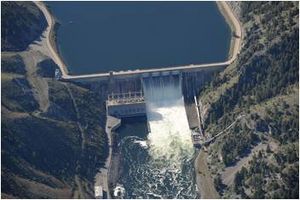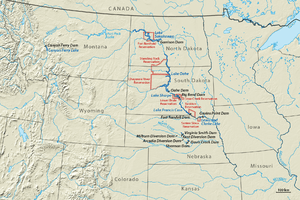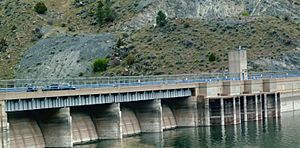Canyon Ferry Dam facts for kids
Quick facts for kids Canyon Ferry Dam |
|
|---|---|
 |
|
|
Location of the dam in Montana, USA
|
|
| Country | United States |
| Location | Lewis and Clark County, Montana, USA |
| Coordinates | 46°38′54″N 111°43′39″W / 46.64833°N 111.72750°W |
| Status | Operational |
| Construction began | May 24, 1949 |
| Opening date | June 23, 1954 |
| Owner(s) | U.S. Bureau of Reclamation |
| Dam and spillways | |
| Type of dam | Gravity |
| Impounds | Missouri River |
| Height | 225 ft (69 m) |
| Length | 1,000 ft (305 m) |
| Width (crest) | 20 ft (6 m) |
| Width (base) | 173 ft (53 m) |
| Dam volume | 414,400 cu yd (316,832 m3) |
| Spillway type | Service, four controlled-gates |
| Spillway capacity | 150,000 cu ft/s (4,248 m3/s) |
| Reservoir | |
| Creates | Canyon Ferry Lake |
| Total capacity | 1,997,900 acre⋅ft (2.4644 km3) |
| Normal elevation | 3,797 ft (1,157 m) |
| Power station | |
| Commission date | 1953–1954 |
| Turbines | 3 x 16.5 MW Francis-type |
| Installed capacity | 50 MW |
| Annual generation | 277,052,777 KWh |
Canyon Ferry Dam is a large concrete dam in the United States. It sits in a narrow valley of the Missouri River in Montana. This area is where the Big Belt Mountains and the Spokane Hills meet. The dam is about 68 miles (109 km) downstream from where three rivers (Gallatin, Madison, and Jefferson) join. It is also about 20 miles (32 km) east of Helena, Montana.
The dam helps control floods and provides water for farming. It also creates a fun place for recreation and generates electricity. The building of the dam formed a large reservoir called Canyon Ferry Lake.
Building the Dam
In 1941, experts first studied the idea of building this dam. This study was done by the Bureau of Reclamation, the Montana Water Board, and the Montana Power Company. The dam and its power plant were part of a much bigger plan. This plan was called the Pick-Sloan Plan. It aimed to manage the entire Missouri River basin.
The U.S. government approved the dam project in 1944. Construction of the Canyon Ferry Unit began on May 24, 1949. It was finished on June 23, 1954. The power plant started working in stages. Its first generator began producing electricity on December 18, 1953. The other two generators were ready in 1954.
This 1949 dam replaced an older one. The original Canyon Ferry Dam was about 1.5 miles (2.4 km) upstream. It was built between 1896 and 1898. That old dam was made of timber and rock. It was 29 feet (9 m) high and 485 feet (148 m) long.
How the Dam is Built
Canyon Ferry Dam is a type of dam called a concrete gravity dam. This means its huge weight holds it in place. The dam stands 225 feet (69 m) tall. It stretches 1,000 feet (305 m) long.
At the top, the dam is 20 feet (6 m) wide. At its base, it is much wider, at 173 feet (53 m). The entire dam structure used a massive amount of concrete. It contains about 414,400 cubic yards (316,800 m³) of concrete.
The dam has a spillway in its middle section. A spillway is like a giant drain that releases extra water. It has four special gates that control the water flow. This spillway can release up to 150,000 cubic feet (4,248 m³) of water per second.
Next to the spillway is the dam's power plant. This plant has three large machines called Francis turbine generators. Each generator can produce 16.5 MW (megawatts) of power. Together, they can generate a total of 50 MW of electricity. Water flows to each turbine through a large pipe called a penstock, which is 13.5 feet (4.1 m) wide.
The dam creates Canyon Ferry Lake. When the lake is at its normal level, it holds about 1,891,000 acre-feet (2.33 km³) of water. The normal water level of the lake is 3,797 feet (1,157 m) above sea level.




